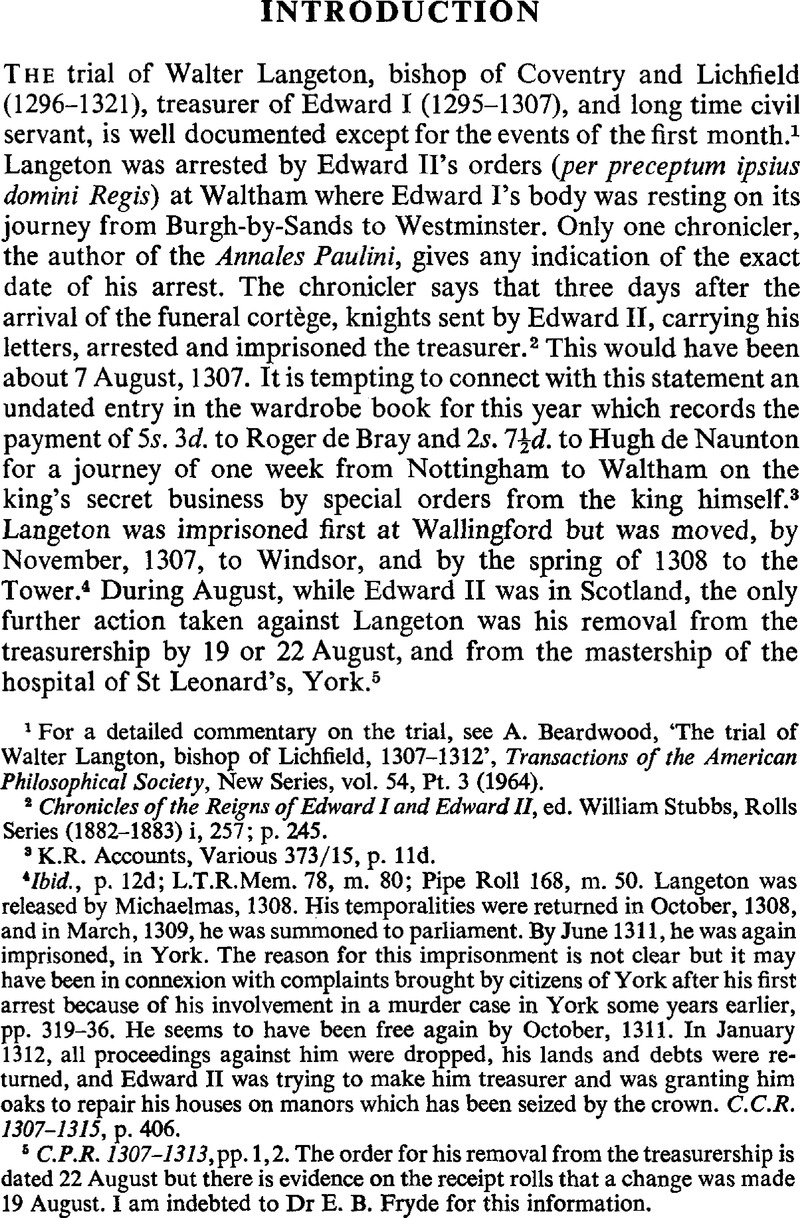No CrossRef data available.
Article contents
Introduction
Published online by Cambridge University Press: 21 December 2009
Abstract

- Type
- Introduction
- Information
- Copyright
- Copyright © Royal Historical Society 1965
References
page 1 note 1 For a detailed commentary on the trial, see Beardwood, A., ‘The trial of Walter Langton, bishop of Lichfield, 1307–1312’, Transactions of the American Philosophical Society, New Series, vol. 54, Pt. 3 (1964).CrossRefGoogle Scholar
page 1 note 2 Chronicles of the Reigns of Edward I and Edward II, ed. William Stubbs, Rolls Series (1882–1883) i, 257Google Scholar; p. 245.
page 1 note 3 Accounts, K. R., Various 373/15, p. 11d.Google Scholar
page 1 note 4 Ibid., p. 12d; L.T.R.Mem. 78, m. 80; Pipe Roll 168, m. 50. Langeton was released by Michaelmas, 1308. His temporalities were returned in October, 1308, and in March, 1309, he was summoned to parliament. By June 1311, he was again imprisoned, in York. The reason for this imprisonment is not clear but it may have been in connexion with complaints brought by citizens of York after his first arrest because of his involvement in a murder case in York some years earlier, pp. 319–36. He seems to have been free again by October, 1311. In January 1312, all proceedings against him were dropped, his lands and debts were returned, and Edward II was trying to make him treasurer and was granting him oaks to repair his houses on manors which has been seized by the crown. C.C.R. 1307–1315, p. 406.Google Scholar
page 1 note 5 C.P.R. 1307–1313, pp. 1, 2Google Scholar. The order for his removal from the treasurership is dated 22 August but there is evidence on the receipt rolls that a change was made 19 August. I am indebted to Dr E. B. Fryde for this information.
page 2 note 1 K.R.Mem. 81, mm. 16, 84; C.F.R. 1307–1313, p. 3Google Scholar. The extents were to be enrolled and sent to the king at Clipston. The roll, if made, seems not to have survived.
page 2 note 2 K.R.Mem. 81, m. 79d; Exchequer Writs 3.
page 2 note 3 K.R.Mem. 81, mm. 67, 79d. On 6 October, John Scot was paid 5 shillings for his expenses in arresting John Langeton. Issue Roll 141.
page 2 note 4 P. 243.
page 2 note 5 L.T.R.Mem. 78, m. 87. Some chroniclers say that Edward and Gaveston were present at the Temple and that the treasure was given to Gaveston, along with all other wealth of Langeton and Edward I. Walter of Guisborough says that the land was valued at 5,000 marks per annum, the treasure 50,000 marks of silver plus gold and jewels. Although there is no accounting for what was seized at the Temple, it is clear from wardrobe books and the enrolled accounts of Langeton's lands that the chroniclers' statements are untrue: The Chronicle of Walter of Guisborough, ed. H. Rothwell, Camden Series (1957), p. 383.Google Scholar
page 2 note 6 Accounts, K. R., Various, 373/15, pp. 2d, 12, 43dGoogle Scholar; pp. 243–45.
page 3 note 1 Exchequer Writs 3; K.R.Mem. 85, m. 50d; p. 241.
page 3 note 2 The exchequer seems not to have had a list of statute merchant towns because six of the twenty-four towns receiving writs replied they had no statute merchant facilities. Eight towns reported no recognizances to Langeton.
page 3 note 3 P. 243.
page 3 note 4 Pp. 26–34, 173–82.
page 3 note 5 Pp. 11, 152. Some debts outstanding in 1307 seem not to have been investigated on the plea roll. A debt of £100 acknowledged by John fitz Thomas, knight, of Ireland in chancery was noted in Exchequer Writs 3; C.C.R. 1288–1296, p. 380Google Scholar. A debt of £20 acknowledged by Lawrence Preston in 1307 was being collected by Langeton in 1315. Exchequer Plea Roll 40, m. 12. A debt of £22 from the abbot of Lilleshall, payable at Michaelmas, 1307, appears on Exchequer Plea Roll 37, m. 5d. Two mills and land in Staffordshire were also overlooked, pp.133, 182. The rolls of the court of Common Pleas seem not to have been searched for recognizances of debts.
page 4 note 1 P. 21.
page 4 note 2 P. 56.
page 4 note 3 P. 196.
page 4 note 4 Pp. 17, 39, 103.
page 5 note 1 K.R. Accounts, Miscellaneous, 3/7, 3/9.
page 5 note 2 Letter Book C, p. 156.Google Scholar
page 5 note 3 C.P.R. 1307–1313, pp. 36, 37, 86.Google Scholar
page 5 note 4 Ibid., p. 255.
page 6 note 1 P. 302.
page 6 note 2 C.C.R. 1307–1313, p. 28.Google Scholar
page 7 note 1 P. 57.
page 7 note 2 Pp. 319 n., 336.
page 7 note 3 P. 199.
page 7 note 4 P. 96.
page 7 note 5 P. 95.




